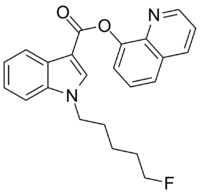Content deleted Content added
No edit summary |
No edit summary |
||
| Line 36: | Line 36: | ||
==Pharmacology== |
==Pharmacology== |
||
5F-PB-22 acts as a [[full agonist]] with a [[Affinity (pharmacology)#Protein-ligand binding|binding affinity]] of 0.468nM at [[Cannabinoid receptor type 1|CB<sub>1</sub>]] and 0.633nM at [[Cannabinoid receptor type 2|CB<sub>2</sub>]] [[cannabinoid]] receptors.<ref>Hess |
5F-PB-22 acts as a [[full agonist]] with a [[Affinity (pharmacology)#Protein-ligand binding|binding affinity]] of 0.468nM at [[Cannabinoid receptor type 1|CB<sub>1</sub>]] and 0.633nM at [[Cannabinoid receptor type 2|CB<sub>2</sub>]] [[cannabinoid]] receptors.<ref>{{cite journal|first1=Cornelius|last1=Hess|first2=ClaraT.|last2=Schoeder|first3=Thanigaimalai|last3=Pillaiyar|first4=Burkhard|last4=Madea|title=Pharmacological evaluation of synthetic cannabinoids identified as constituents of spice|journal=Forensic Toxicology|date=1 July 2016|issn=1860-8965|pages=329–343|volume=34|issue=2|doi=10.1007/s11419-016-0320-2|first5=ChristaE.|last5=Müller|pmid=27429655|pmc=4929166}}</ref> |
||
==Legal Status== |
==Legal Status== |
||
Revision as of 03:29, 2 August 2016
 | |
| Legal status | |
|---|---|
| Legal status |
|
| Identifiers | |
| |
| CAS Number | |
| ChemSpider | |
| CompTox Dashboard (EPA) | |
| Chemical and physical data | |
| Formula | C23H21FN2O2 |
| Molar mass | 376.42 g/mol g·mol−1 |
| 3D model (JSmol) | |
| |
| |
5F-PB-22 (5F-QUPIC or Quinolin-8-yl 1-pentyfluoro-1H-indole-3-8-carboxylate) is a designer drug which acts as a cannabinoid agonist.[1] The structure of 5F-PB-22 appears to have been designed with an understanding of structure-activity relationships within the indole class of cannabinoids.[2]
Pharmacology
5F-PB-22 acts as a full agonist with a binding affinity of 0.468nM at CB1 and 0.633nM at CB2 cannabinoid receptors.[3]
Legal Status
As of October 2015 5F-PB-22 is a controlled substance in China.[4]
In January 2014, 5F-PB-22 was designated as a Schedule I controlled substance in the United States after several deaths were associated with its use.[5][6]
See also
References
- ^ Banister, S. D.; Stuart, J.; Kevin, R. C.; Edington, A.; Longworth, M.; Wilkinson, S. M.; Beinat, C.; Buchanan, A. S.; Hibbs, D. E.; Glass, M.; Connor, M.; McGregor, I. S.; Kassiou, M. (2015). "Effects of Bioisosteric Fluorine in Synthetic Cannabinoid Designer Drugs JWH-018, AM-2201, UR-144, XLR-11, PB-22, 5F-PB-22, APICA, and STS-135". ACS Chemical Neuroscience. 6 (8): 150508124201002. doi:10.1021/acschemneuro.5b00107.
- ^ "5F-PB-22". Forendex. Retrieved 24 June 2015.
- ^ Hess, Cornelius; Schoeder, ClaraT.; Pillaiyar, Thanigaimalai; Madea, Burkhard; Müller, ChristaE. (1 July 2016). "Pharmacological evaluation of synthetic cannabinoids identified as constituents of spice". Forensic Toxicology. 34 (2): 329–343. doi:10.1007/s11419-016-0320-2. ISSN 1860-8965. PMC 4929166. PMID 27429655.
- ^ "关于印发《非药用类麻醉药品和精神药品列管办法》的通知" (in Chinese). China Food and Drug Administration. 27 September 2015. Retrieved 1 October 2015.
- ^ Behonick, G; Shanks, K. G.; Firchau, D. J.; Mathur, G; Lynch, C. F.; Nashelsky, M; Jaskierny, D. J.; Meroueh, C (2014). "Four Postmortem Case Reports with Quantitative Detection of the Synthetic Cannabinoid, 5F-PB-22". Journal of analytical toxicology. 38 (8): 559–62. doi:10.1093/jat/bku048. PMC 4334789. PMID 24876364.
- ^ Jordan Trecki; Roy R. Gerona; Michael D. Schwartz (July 2015). "Synthetic Cannabinoid–Related Illnesses and Deaths". New England Journal of Medicine. 373 (2): 103–107. doi:10.1056/NEJMp1505328. PMID 26154784.